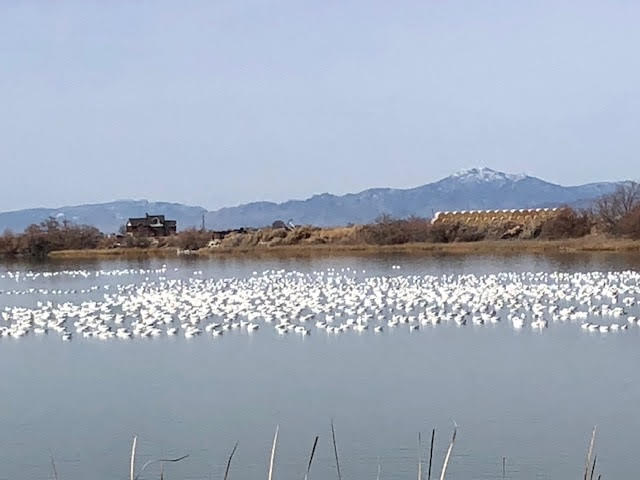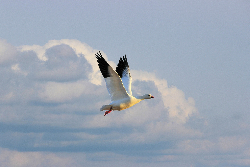
Gunnison Bend Reservoir
Delta Utah
Courtesy & Copyright Mary Heers, Photographer
Right on schedule thousands of snow geese fly in from as far south as Mexico to fatten up on the spilled grain in the local farmer’s fields, and rest a bit before continuing their migration to the far north.
I arrived at about noon and sure enough found a few hundred of the white geese bobbling peacefully in the reservoir just outside of town. Then came a great crescendo of geese calls and I looked up. A couple hundred more geese were flying in like a precision jet team. They lowered their feet and waterskied to a soft landing, somehow managing not to bump into each other. And then the scene quieted down. It was time for a long afternoon nap.
Perhaps these geese wondered why so many spectators had come to the reservoir to watch them nap on their day off. But we had come to marvel at their ability to catch the slow rising tide of lengthening days and ride it to the north, timing their arrival to the melting of snow and greening of the arctic tundra. In the far north, the snow geese will split off into pairs, build their nests, and raise their young.
But in the fall, they will form up in large flocks once again for the return trip because they know flying together is far more efficient than flying alone. People that study the physics of flying tell us that birds can get an energy savings of 65% from the free lift of upward airflow around another bird’s wing tips.
A few years ago, I had read a book about a man in Ontario, Canada, Bill Lishman, who had carried out a migration experiment with geese. I dug out my copy of his book, Father Goose, and reread it.
Bill had hatched some Canada goose eggs in an incubator at his home. The geese followed him everywhere, toddling across his lawn, swimming in his pond, and going airborne while chasing him on his motorcycle. One goose liked to fly inches above his head, looking a lot like the bill of an amazing baseball cap. Eventually Bill coaxed the geese into the air behind his ultralight plane.
Could these young geese, raised without adult geese role models, be able to migrate? Bill launched his trial – a 400-mile fall journey from Ontario to a nature reserve in Virginia. The geese flew with Bill’s plane for 7 days, overnighting along the way, and settled down for the winter.
The next big question lay ahead: would the geese be able to find their way home unaided in the spring?
Unexpectedly, on April 1, the geese took off under cover of night. For two weeks, Bill and his team searched for them to no avail. Then Bill got a phone call from his wife. The geese had returned and were waiting for him on the lawn in front of his house in Ontario.
Did they remember landmarks in the terrain they had crossed on the way south? Did they navigate by the sun and stars?
Bill had shown that young geese could find their way home. But just exactly how they did it is still a very well-kept secret.
This is Mary Heers and I’m Wild About Utah
Credits:
Photos: Courtesy & Copyright Mary Heers, Photographer
Featured Audio: Courtesy & Copyright Mary Heers
Text: Mary Heers, https://cca.usu.edu/files/awards/art-and-mary-heers-citation.pdf
Additional Reading: Lyle Bingham, https://bridgerlandaudubon.org/
Additional Reading
Wild About Utah, Mary Heers’ Postings
See thousands of geese migrating through Utah during the 2024 Delta Snow Goose Festival, Feb 1, 2024, https://wildlife.utah.gov/news/utah-wildlife-news/1842-see-thousands-of-geese-migrating-during-the-2024-delta-snow-goose-festival.html
Snow Goose Festival, Delta Area Chamber of Commerce, https://www.deltautahchamber.com/snowgoosefestival
Snow Goose Festival, Millard County Tourism, https://visitmillardcounty.com/events/snowgoosefestival/
Snow Goose Festival Video, Utah Division of Wildlife Resources, https://fb.watch/r0SBEaTY5i/
Snow Goose | Canada Goose Comparison, All About Birds, Cornell Lab of Ornithology, Cornell University, https://www.allaboutbirds.org/guide/Canada_Goose/species-compare/59939631

